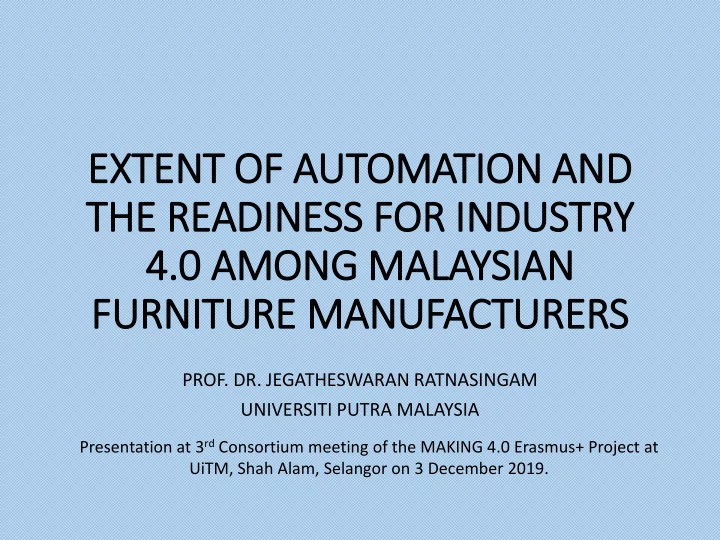

EXTENT OF AUTOMATION AND THE READINESS FOR IN INDUSTRY 4.0 AMONG MALAYSIAN FURNITURE MANUFACTURERS PROF. DR. JEGATHESWARAN RATNASINGAM UNIVERSITI PUTRA MALAYSIA Presentation at 3 rd Consortium meeting of the MAKING 4.0 Erasmus+ Project at UiTM, Shah Alam, Selangor on 3 December 2019.
The Malaysian Wood-Based Industry • Malaysia has traditionally been an important producer and exporter of tropical wood products in the world. • In realizing the value of the forest resources, the government embarked on a series of Industrial Master Plans, aimed at transforming the wood- based industry, from being a net exporter of primary produces to become a net exporter of value-added wood products. • The first IMP (1986- 1995) encouraged further down-stream processing as the exportation of primary produces, were curtailed through export ban, imposition of export levy and export quotas.
• The second IMP (1996 – 2005) encouraged the manufacture of value- added products, especially furniture, builders, carpentry & joinery (BCJ), moldings, etc . • The third IMP (2006 – 2020) is focused on increasing the extent of value-addition in the furniture, BCJ, and other value-added products, through design, innovation, and branding . • The formulation of the National Timber Industry Plan (NATIP) in 2009 further emphasized the commitment of the government to foresee the further development of the wood-based industry, through seven strategic pillars. • In this context, the industrial policy formulations and its implementations have contributed positively towards the transformation of the Malaysian wood-based industry into an export-oriented powerhouse of value-added wood products.
The Malaysian Furniture Industry • From an industrial perspective, the fastest growing sub-sector within the Malaysian wood-based industry has been the furniture sector. • Its rapid export growth from about RM 40 million in 1982 to RM 9.83 billion in 2018 clearly underscores the importance of this sub-sector within the overall wood-based industry. • The Malaysian furniture industry is currently an important socioeconomic sector in the country, contributing in excess of USD 2 billion annually in foreign exchange, while providing employment to almost 93,000 workers. • When the domestic market for furniture is taken into consideration, the net volume of furniture produced within the country exceeds USD 3.2 billion per annum. Hence, the furniture industry has earned the accolade of being the star performer within the overall Malaysian wood industry.
10,000,000,000 9,000,000,000 8,000,000,000 7,000,000,000 Export V alue (RM) 6,000,000,000 5,000,000,000 4,000,000,000 3,000,000,000 2,000,000,000 1,000,000,000 0 2008 2009 2010 2011 2012 2014 2015 2016 2017 Furmiture Parts 441,974,0 436,997,0 442,318,9 474,446,2 494,441,2 505,515,0 513,444,2 546,788,1 589,762,0 Others Furniture 77,943,14 74,283,49 88,081,92 86,630,77 87,110,04 90,442,14 91,040,56 91,768,12 91,918,11 Metal Furniture 904,485,5 672,683,4 665,017,6 666,145,2 666,545,1 689,141,0 694,223,0 701,110,4 704,114,3 Rattan Furniture 34,616,34 29,636,36 31,158,47 25,051,93 25,010,33 24,889,10 24,766,10 24,101,22 23,877,14 Wooden Furniture 6,921,086 6,248,217 6,521,646 6,201,495 6,743,515 7,656,711 8,217,813 8,678,994 8,944,567 Type of furniture export from Malaysia, 2008-2017. Values are shown in RM Million. (Source: Department of Statistics, Malaysia).
1.60% 1.40% Contribution of Furniture Export 1.20% 1.00% 0.80% Contribution of Furniture 0.60% Export Share to GDP (%) 0.40% 0.20% 0.00% Contribution of furniture export value share to gross domestic product (GDP) of Malaysia (Source: Department of Statistics, Malaysia)
Extent of automation in the furniture manufacturing industry
Application of automated technologies in the manufacturing processes of furniture
Application of automation in the various stages of furniture manufacturing
Factors Encouraging the Use of Automated Technologies in Furniture Manufacturing Operations Manufacturing Processes Factors Encouraging the Use of Automated Technologies Rough Milling Capacity, Just-in-Time, Consistent Quality, High Productivity Machining Centers Lack of Skilled Workers, Low Cost, Improved, and Consistent Quality, High Number of Workers Abrasive Sanding Increased Productivity, Capacity, Consistent Quality, High Number of Workers, Low Cost, Reduce Pollutants Gluing & Assembly Just-In-Time, Consistent Quality, Capacity Surface Coating Improved Quality, Higher Standards, Reduce Pollutants, High Productivity, Lack of Skilled Workers, Reduce Number of Workers Packaging Capacity, Low Cost, Consistent Quality
Specific automated technologies used in the Malaysian furniture industry
CONCLUSION 1. The extent of automation application within Malaysia’s furniture manufacturing industry is presently highest in the machining and finishing/coating operations. 2. Computer numerical control (CNC), computer aided design (CAD), sorting systems, and automatic spraying technologies were the automated technologies most prominently used in the furniture manufacturing industry. 3. The panel-based furniture industry is more automated compared to other types of furniture manufacturing due to its need for standardized components, higher capacity, and lower unit cost. 4. Generally, the diffusion of automated technologies and information and computer technologies (also referred to as Industry 3.0) within the Malaysian furniture industry is limited, and therefore the probability and readiness among furniture manufacturers for implementing Industry 4.0 is relatively low.
Announcement • The Faculty of Forestry in collaboration with P.E. Research Magnets Sdn. Bhd. has been awarded a scoping study grant by the EPU, to map the assimilation pathway for the implementation of IR4.0 technologies in the wood industry, particularly in the value-added sector with a net reduction of up to 20,000 workers. • Project duration: Sept 2019 – Sept 2021.
Recommend
More recommend